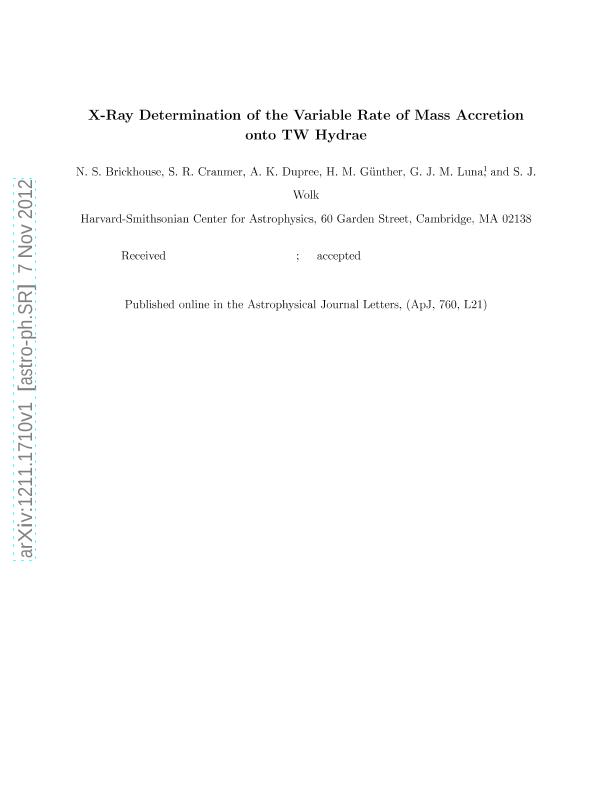Mostrar el registro sencillo del ítem
dc.contributor.author
Brickhouse, N. S.
dc.contributor.author
Cranmer, S. R.
dc.contributor.author
Dupree, A. K.
dc.contributor.author
Günther, H. M.
dc.contributor.author
Luna, Gerardo Juan Manuel

dc.contributor.author
Wolk, S. J.
dc.date.available
2017-07-04T20:16:00Z
dc.date.issued
2012-11-05
dc.identifier.citation
Brickhouse, N. S.; Cranmer, S. R.; Dupree, A. K.; Günther, H. M.; Luna, Gerardo Juan Manuel; et al.; X-Ray Determination of the Variable Rate of Mass Accretion onto TW Hydrae; IOP Publishing; The Astrophysical Journal Letters; 760; 2; 5-11-2012; L21,1-5
dc.identifier.issn
2041-8205
dc.identifier.uri
http://hdl.handle.net/11336/19528
dc.description.abstract
Diagnostics of electron temperature (Te), electron density (ne), and hydrogen column density (NH) from the Chandra High Energy Transmission Grating spectrum of He-like Ne ix in TW Hydrae (TW Hya), in conjunction with a classical accretion model, allow us to infer the accretion rate onto the star directly from measurements of the accreting material. The new method introduces the use of the absorption of Ne ix lines as a measure of the column density of the intervening, accreting material. On average, the derived mass accretion rate for TW Hya is 1.5 × 10−9 M yr−1, for a stellar magnetic field strength of 600 G and a filling factor of 3.5%. Three individual Chandra exposures show statistically significant differences in the Ne ix line ratios, indicating changes in NH, Te, and ne by factors of 0.28, 1.6, and 1.3, respectively. In exposures separated by 2.7 days, the observations reported here suggest a five-fold reduction in the accretion rate. This powerful new technique promises to substantially improve our understanding of the accretion process in young stars.
dc.format
application/pdf
dc.language.iso
eng
dc.publisher
IOP Publishing

dc.rights
info:eu-repo/semantics/openAccess
dc.rights.uri
https://creativecommons.org/licenses/by-nc-sa/2.5/ar/
dc.subject
Accretion, Accretion Disks
dc.subject
Stars: Formation
dc.subject
Stars: Individual (Tw Hydrae)
dc.subject
Techniques: Spectroscopic
dc.subject.classification
Astronomía

dc.subject.classification
Ciencias Físicas

dc.subject.classification
CIENCIAS NATURALES Y EXACTAS

dc.title
X-Ray Determination of the Variable Rate of Mass Accretion onto TW Hydrae
dc.type
info:eu-repo/semantics/article
dc.type
info:ar-repo/semantics/artículo
dc.type
info:eu-repo/semantics/publishedVersion
dc.date.updated
2017-07-04T14:08:46Z
dc.journal.volume
760
dc.journal.number
2
dc.journal.pagination
L21,1-5
dc.journal.pais
Reino Unido

dc.journal.ciudad
Londres
dc.description.fil
Fil: Brickhouse, N. S.. Harvard-Smithsonian Center for Astrophysics; Estados Unidos
dc.description.fil
Fil: Cranmer, S. R.. Harvard-Smithsonian Center for Astrophysics; Estados Unidos
dc.description.fil
Fil: Dupree, A. K.. Harvard-Smithsonian Center for Astrophysics; Estados Unidos
dc.description.fil
Fil: Günther, H. M.. Harvard-Smithsonian Center for Astrophysics; Estados Unidos
dc.description.fil
Fil: Luna, Gerardo Juan Manuel. Consejo Nacional de Investigaciónes Científicas y Técnicas. Oficina de Coordinación Administrativa Ciudad Universitaria. Instituto de Astronomía y Física del Espacio. - Universidad de Buenos Aires. Facultad de Ciencias Exactas y Naturales. Instituto de Astronomía y Física del Espacio; Argentina
dc.description.fil
Fil: Wolk, S. J.. Harvard-Smithsonian Center for Astrophysics; Estados Unidos
dc.journal.title
The Astrophysical Journal Letters
dc.relation.alternativeid
info:eu-repo/semantics/altIdentifier/url/http://iopscience.iop.org/article/10.1088/2041-8205/760/2/L21/meta
dc.relation.alternativeid
info:eu-repo/semantics/altIdentifier/doi/http://dx.doi.org/10.1088/2041-8205/760/2/L21
dc.relation.alternativeid
info:eu-repo/semantics/altIdentifier/url/https://arxiv.org/abs/1211.1710
Archivos asociados
